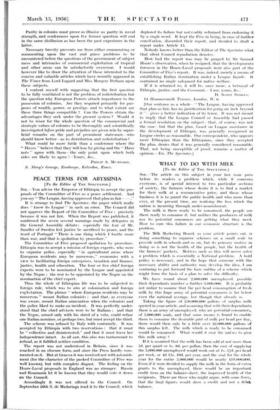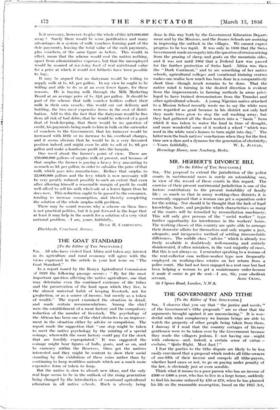WHAT TO DO WITH MILK
[To the Editor of THE SeEcTATon.1
SIR,—The article on this subject in your last issue puts before its readers a problem which, while it concerns everyone, is of special interest to two particular sections of society, the farmers whose desire it is to find a market for their milk at a remunerative price, and those whose
business it is to guard the public health and who more than ever, at the present time, are realising the loss which the nation is incurring through.under-nourishment.
The milk is there ready to be consumed, the people are there ready to consume it, but neither the producers of milk nor its potential consumers are getting what they need. How to cure this failure in our economic structure is the problem.
The Milk Marketing Board, as your article points out. is doing something to organise schemes on a small scale to provide milk in schools and so on, but its primary motive in doing so is not the health of the people, but the health of the farmers' pockets. Motives such as this will never solve a problem which is essentially a National problem. A bold policy is necessary, and in the hope that someone with the necessary ability and authority may develop the idea, I nun venturing to put forward the bare outline of a scheme which might form the basis of a plan to solve the difficulty.
We have round about. 2,000,000 unemployed, possibly their dependants number a further 3,000,000. It is probably not unfair to assume that the per head consumption of fresh milk by this huge army of potential consumers is far below even the national average, low though that already is.
Taking the figure of 250,000,000 gallons of surplus milk quoted in your article, and assuming that with their deiwndants there is an army of unemployed, who are potential consumers, of 5,000,000 souls, and that some means is found to enable them to consume the desirable pint of milk per head per day, there would then only be a little over 22,000,000 gallons of this surplus left. The milk which is ready to be eons 41 would be consumed. What would it cost the nat:o.i to give this milk away ?
If it is assumed that the milk has been sold at not more than 5d. per quart or Is. 8d. per gallon, then the cost of supplying the 5,000,000 unemployed would work out at Is. 50. per head per week, or £3 ISs. 10d. per year, and the cost for the whole year for the entire 5,000,000 would be nearly £19,000,000. Even if it were decided to supply the milk in the form of extra grants to the unemployed, there would be an important credit item on the balance-sheet, the improved health of the recipients. There are those who might argue, with some force, that the final figures would show a credit and not a debit balance.
Is it necessary, however, to give the whole of this £19,000,000 away ? Surely there would Ix• some justification and many advantages in a system of milk vouchers forming part of the dole payments, leaving the total value of the cash payments, plus vouchers, at the same figure as before. This would, in effect, mean that the scheme would cost the nation nothing, apart from administrative expenses, but that the unemployed would be assured of rccAving food of real nutritional value for a price at which it would not hitherto have been possible to buy.
It may be argued that no dairyman would be willing to supply milk at Is. 8d. per gallon. In my view he ought to be willing and able to do so at an even lower figure, for these reasons. lie is buying milk through the Milk Marketing Board at an average price of Is. 30. per gallon. It should be part of the scheme that milk voucher holders collect their milk in their own vessels; this would cut out delivery and bottling, the two most expensive items in the cost of distri- bution. Add to this the fact that the dairyman would be free from all risk of bad debts, that he would be relieved of a good deal of book-keeping, that there would be no question of credit, his payments being made to him in bulk on the surrender of vouchers to the Government, that his turnover would be increased with little or no increase to his overhead charges, and it seems obvious that he would be in a very favoured position indeed, and might even be able to sell at ls. 6d. per gallon and make a handsome profit into the bargain.
One wond about the farmer's point of view. There are 250,000,000 gallons of surplus milk at present, and because of that surplus the farmer is paying a heavy levy amounting to as much as ad. per gallon, in order to subsidise the price of that milk which goes into manufacture. Reduce that surplus to 22,000,000 gallons and the levy which is now necessary will he very greatly reduced, possibly to such an extent that even after allowing himself a reasonable margin of profit he could well afford to sell his milk wholesale at a lower figure than he does now. This reduction ought to be passed to the consumer, tending to increase consumption, and thereby completing the solution of the whole surplus milk problem.
There may be sound reasons why a scheme on these lines is not practical polities, but it is put forward in the hope that at least it may help in the search for a solution of a very vital national problem.—I am, yours faithfully,















































 Previous page
Previous page